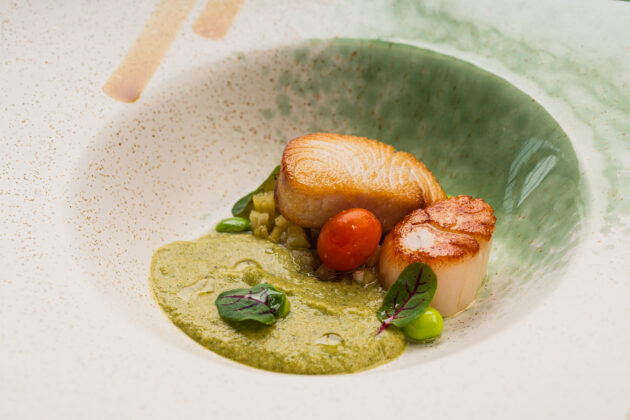Philippine history on a plate
Tatung Sarthou’s 10-course degustation in Lore honors all the regions of the archipelago
By Joseph L. Garcia, Reporter
“ANOTHER Tatung restaurant,” one might say, but Lore is different from anything the celebrity chef has done before.
During a tasting late last month at his new restaurant, Lore, Myke “Tatung” Sarthou, who has won at the Gourmand World Cookbook Awards for his books, presented a 10-course menu that felt like a long love letter to the Philippines. In a “feasting” (not a tasting) degustacion, all the country’s regions were lovingly represented, each dish evoking a memory of something to love about this country.
For starters, Mr. Sarthou presented homemade bread with three spreads: an indulgent chicken galantine with raisin jam, chicken liver pate, and tinapa (smoked fish) butter. A kinilaw (raw fish dressed with acid) of tuna and sea urchin with pickled pineapple and sweet potato strings was laid out on a mother-of-pearl shell and sprinkled with sea salt, a worthy praise to the fish. A Camaron Relyeno (stuffed prawn), made with a fried prawn-stuffed sausage wrapped in caul fat and infused with five-spice powder, was served with a sauce made with Haw Flakes (a Chinese-inspired candy made with plums). It smelled and tasted like Chinatown, and reminded one of kikiam (a Chinese pork dish), albeit one made by fairies, maybe.
A Lumpia Fresca (fresh spring roll) inspired by Cebu’s own Chinatown — Mr. Sarthou hails from Cebu — had shrimp, crab, and turnip peeking through a blanket of squid ink crepe, served with a garlic sauce and dots of cilantro gel. The freshness in its nature warranted the name, and the seafood played with the crisp turnip, while the garlic cream sauce brought a smile. This particular dish was inspired by a recipe from the 1918 book Condimentos Indeginas by beauty queen and journalist Pura Kalaw.
A Mariscos con Sarsa Verde (seafood with green sauce) tried to bring back memories of old Pampanga with smoked hamachi and seared scallops with a green puree of spinach, green tomatoes, and almonds. The green paste gave gravitas to the clean flavors of the fish, each ingredient so bright and clear that it was almost a palate cleanser by itself.
Another dish inspired by Condimentos Indeginas was the Pato con Salsa Tsokolate, duck with a chocolate sauce with grilled corn salsa. This was arguably the star of the show, with depth and nuance while the duck itself was robust, forward with a flavor that suggested a sense of completeness.
A strawberry sorbet cleansed the palate, setting the stage for a Bringhe (a local paella) with coconut-infused adlai grain topped with jamon de Bulacan and seared foie gras and garnished with clam foam. The ingredients are undoubtedly luxurious and a delight, but the adlai grain centers all of it and brings it back down to earth.
Moros y Kristiano (Muslims and Christians), a signature of Mr. Sarthou due to his admiration for Mindanao, sees slow-braised short ribs in black and white coconut sauces served with pickled eggplants. The black sauce is made by burning the coconut and grounding it into a paste, and the effect gives it a taste of the summer sun, making everything it touches rich and earthy.
The meal ended with a Mango Jubilee, a sponge cake drenched in tres leches, its mango filling flambeed at the table.
Mr. Sarthou began his career in the culinary world with a private dining establishment in Quezon City. After opening strings of restaurants, appearing on TV, and writing award-winning cookbooks, he slowed down this year by going back to his roots with a private dining establishment in Antipolo, as well as opening Lore (with the help of restaurateurs George Pua and Jackson Go).
Known for his YouTube channel Simpol, which teaches Filipino cuisine in a format that’s simple and relatable, we ask this chef about the upscale direction of Lore (the 10-course degustacion costs P4,800). “I made something I really wanted to do. You can’t go upscale if you if you’re not ready. I just reached a point where probably I’m more ready. I have the capacity to do it, and I’m going for it. It’s now or never,” he said.
“I don’t want to end my career not aiming high enough,” he said. “It’s not about being upscale — it’s really having a platform where you can be able to express your cooking philosophy.”
Self-taught in the kitchen and with a past in journalism, Lore serves as a stage for his own storytelling skills — here, the stories are told not through words, but through taste. The story he’s trying to tell here is the global nature of Filipino food, shaped as it was by centuries of trade.
“We have to acknowledge that once in history, the Philippines was a center of trade,” he said, pointing to regional trade that gave us Southeast Asian flavors and Chinese influence, but also European and American colonial overtures that shape what we consume today. All this is scattered on the background that is our Filipino nature, and how we shape what we have been given to something that is ours alone.
“How do you tell the story of Filipino cuisine? It’s to really try to find your roots, try to connect the dots, and tell it in a manner that is elegant and fluid,” he said.
“Philippine cuisine is really more than what we give it credit for,” he said. “It’s really about Filipino ingenuity, creativity, resourcefulness. I want to be able to tell that.”
Lore is located at the 3rd Level of One Bonifacio High Street Mall in Taguig.






